Skip to content
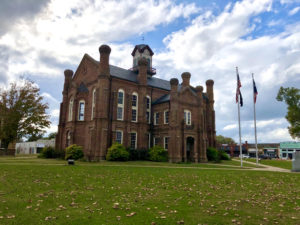
Ahhhh, romantic Irish castles. Something that makes this Irish lady’s heart swoon. But wait…this is no castle at all. It’s actually the Shelby County Courthouse in far east Texas!
Architect John Joseph Emmett Gibson, a native of Ireland who was hired to design the building in Center Texas in 1883, wanted to give his masterpiece the appearance of the castles of his homeland complete with turrets, towers and even secret passageways.
Gibson not only designed and oversaw the construction of the two-story Romanesque Revival courthouse, he had over two million bricks specially made for the project. The mortar was made from sand carried from forty miles away in Louisiana by oxcarts. The glass, vents, and diamond-shaped braces also made the journey from New Orleans and other Southern ports before being transported by oxen.
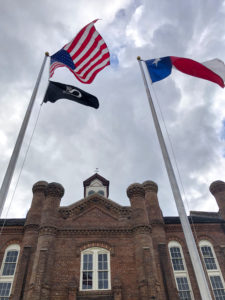 It was a grand undertaking that took two years to complete, but has provided a jewel of a centerpiece to the town square for generations.
It was a grand undertaking that took two years to complete, but has provided a jewel of a centerpiece to the town square for generations.
A total of twelve fireplace chimneys surround the top of the beautiful structure like a crown. Accented with arched entryways, tall slender windows and diminutive buttresses, it’s topped by a frame cupola.
The courthouse has an entry in the middle of each side, but the primary entrance is on the north facade.
The second floor courtroom is a large and lofty space, with exposed wooden trusses supporting the roof that more give the appearance of being inside a cathedral than a courthouse. The curved alcove behind the judge’s bench helped to amplify his voice in the days before sound systems were even a dream.
 The wooden jury chairs aren’t original, having been obtained from another historic Texas courthouse in Nacogdoches. But the benches used by visitors are not only original, they display a decidedly European detail for those who take the time to look closely: metalwork feet depicting dragons’ feet, wind in back of the benches into the beasts’ bodies, wings and ending in heads peering over the top where they are swallowing their own tails. Probably not something most of the local cowboys and farmers had seen before!
The wooden jury chairs aren’t original, having been obtained from another historic Texas courthouse in Nacogdoches. But the benches used by visitors are not only original, they display a decidedly European detail for those who take the time to look closely: metalwork feet depicting dragons’ feet, wind in back of the benches into the beasts’ bodies, wings and ending in heads peering over the top where they are swallowing their own tails. Probably not something most of the local cowboys and farmers had seen before!
Gibson took Texas’ extreme weather into consideration in his design, utilizing high-arched windows that would open allow breezes to circulate air beneath the vaulted ceiling. It provided some relief from the summer heat, but also caused a bit of a problem with birds flying indoors. One funny story tells of the time that an errant bird circling inside the courtroom was such a distraction that the judge asked if someone could do something about it. One loud, reverberating gunshot later the distraction was gone.
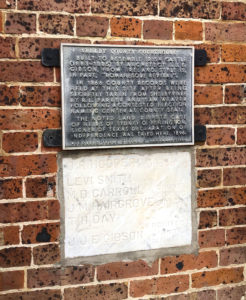
Every good castle should have at least one secret passageway, and the Shelby County Courthouse is no exception. On the floor to the left of the judge’s chair is an escape hatch (yes, really). If the verdict handed down upset the crowd, the judge could open the hatch climb down the stairs and escape through a one-way door. His deputies were in charge of keeping an eye on the crowd until he mounted his horse and got away, before releasing them for the day.
If that were scripted into a Western, it’d be downright comical.
The boards in the center of the courthouse come together at a point said to be the center of the county. When the building was renovated, the local Daughters of the Republic of Texas purchased an 1885 silver dollar coin to have imbedded at that spot.

An interesting side note: In 1948, a young Texas congressman began his successful U. S. Senate campaign in front of the Shelby County Courthouse.
The courthouse, now listed on the National Historic Register, cost $26,000 to build, and over $1 million to renovate in the 1980s. But J.J.E. Gibson was never paid for his work. Whether that was an unfortunate oversight or the county just couldn’t afford it remains a bit of a mystery. The sister to the Shelby County Courthouse, it’s identical 1885 twin in Carthage, Panola County, was unfortunately torn down in 1957.
It probably shouldn’t come as any surprise that Texas has more historic courthouses than any other state, but did you know that of the 254 counties in the state – 242 of these treasured pieces of architecture are still in active government use? They can be a terrific focus for making a road trip checklist – helping you choose large and small towns to visit. Do you have a favorite?


I’ll admit that because Irish (my maiden name is Shanahan), I loved the town of Shamrock even before I arrived just for it’s cute name. What I found is a place that’s adorable for much more than just the moniker it’s had since its first postmaster named it in honor of his Irish mom at the turn of the last century.
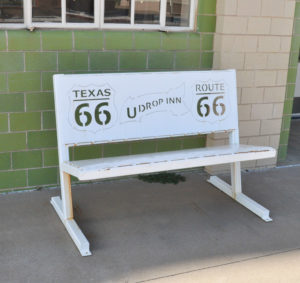
TOWER STATION & U-DROP INN
Of all of the unique stops we made along Route 66 in the Texas panhandle, this small town just 15 miles west of the Oklahoma border had one of the most recognizable buildings to fans of the Pixar movie “Cars.”
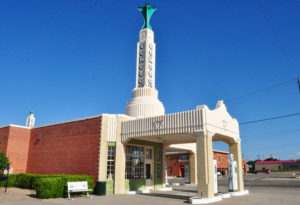
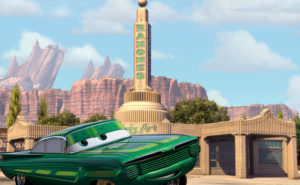
The Conoco gas station and diner at the corner of Highway 83 and Route 66 inspired the design of Ramone’s “House of Body Art” paint and body shop in the film. If you’ve seen the movie, you’re sure to recognize it immediately.
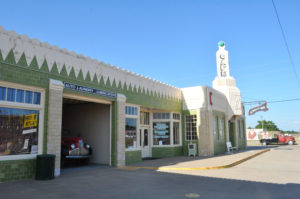
This Art Deco-lover’s dream was designed by Pampa architect J. C. Berry and built by James M. Tindall and R. C. Lewis in 1936, for a whopping $23,000. Quickly nicknamed the “Tower Station,” it was the first commercial business Shamrock had on Route 66.
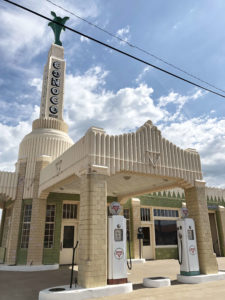
Made up of a streamlined gas station and office, a diner named “U-Drop-Inn” (get it?), and a retail space that was soon incorporated to expand the popular diner.
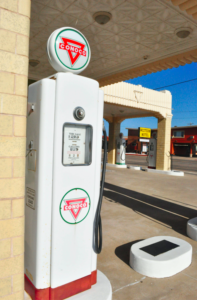
The brick and concrete building sculpted with curved Deco relief curves has two side canopies, and two obelisks sitting on top. The tallest tower over the service station and is almost 100 feet in height. Topped with a metal tulip and adorned with letters spelling “Conoco,” it succeeded in luring in passing tourists. Glazed green and gold terra cotta tile walls and blazing neon light trim added to the attraction, day and night.
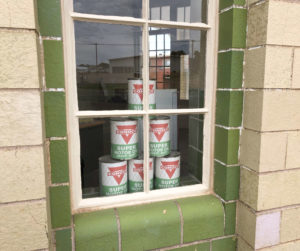
Reported to be “the swankiest of swank eating places” and “the most up to date edifice of its kind on the U.S. Highway 66 between Oklahoma and Amarillo” it quickly became one of the most fashionable stops on the Texas stretch of 66.
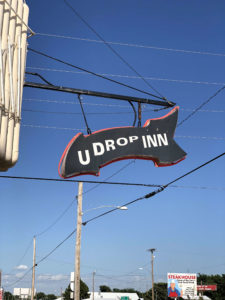
In addition to drawing tourists in from the road, the U-Drop was the place local parents would sit and visit on Saturday nights while their kids were at picture show at the Texas theatre down the street.
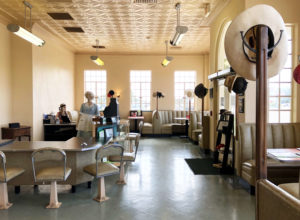
Open 24/7 it had a reputation for friendly waitstaff and delicious food, and was surely a welcome sight for tired, road-weary travelers.
John Nunn, the original owner, passed away in 1957 and the structure changed hands a few times. In the 1970s the station was converted into a Fina station. But the new era had begun when traveling was more focused on the destinations than the adventure of traveling itself, and Route 66 sights took a back seat.
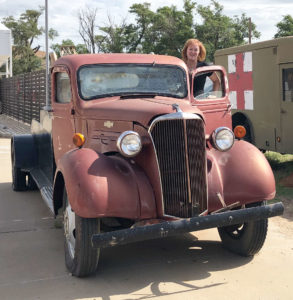
James Tindall, Jr., the son of one of the builders, purchased the landmark in the early 1980s, but closed it in 1997. Ironically that was the same year it was added to the national Register of Historic Places.
Two years later the First National Bank of Shamrock purchased the iconic building and donated to the town of Shamrock. A careful restoration was completed in 2003 recovering its Art Deco charm.
Repair of the station included the use of 508 linear feet of LED lighting to replace the original neon, which was often damaged by harsh Panhandle weather.
Luckily fo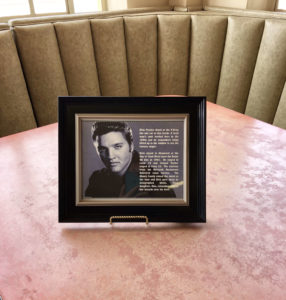 r today’s travelers, the Tower Station complex has been turned into a Visitor Center and small memorabilia museum where you can get a feel for what it was like in its heyday, and sit in Elvis Presley’s favorite booth! They even have era hats to use as props in your photos. The shop also carries a small assortment of Route 66 souvenirs.
r today’s travelers, the Tower Station complex has been turned into a Visitor Center and small memorabilia museum where you can get a feel for what it was like in its heyday, and sit in Elvis Presley’s favorite booth! They even have era hats to use as props in your photos. The shop also carries a small assortment of Route 66 souvenirs.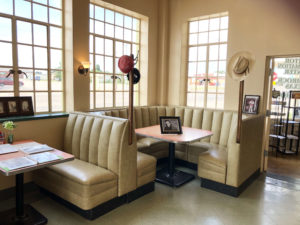
Travelers now come from all over the world once again to visit the Tower Station. One of the ladies volunteering in the shop pointed out that they has already had people there from over 100 countries this year alone.
What you might not expect to find is a row of Tesla car chargers in the side parking lot, but the juxtaposition of old and new is pretty darn neat.
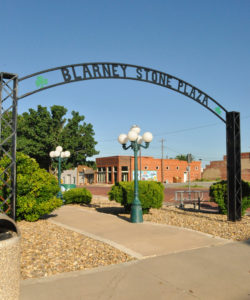
BLARNEY STONE
Kiss It, It’s Irish!
One of Shamrock’s biggest claims to fame is that it has a piece of the actual Blarney Stone from Ireland.
If you aren’t familiar with the original Blarney stone, it is a large piece of limestone built into the battements of Blarney in Cork. According to legend, kissing the stone will endow the kisser with the “gift of gab.” As a writer, I think that could come in pretty darn handy!
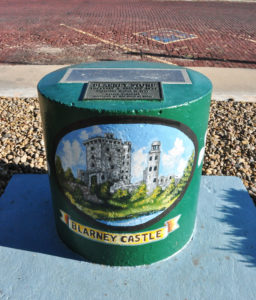
In a tiny strip of property named Elmore Park on East 2nd Street, sits an allegedly theft-proof, crash-proof (for wayward trucks, I assume) concrete cylinder with a neatly cut piece of the legendary stone embedded in the top. The landmark is Irish green – of course – and has a depiction of Blarney Castle painted on the side by a talented local artist.
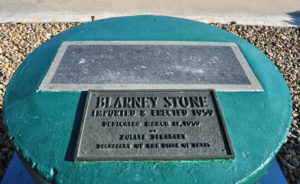
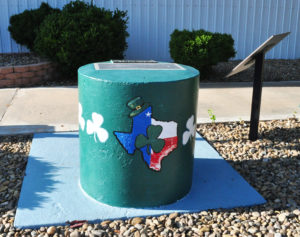
A bronze plaque explains that the stone was placed there on March 17, 1959 (St. Patrick’s Day) by Texas Secretary of State, Zollie Stearley. According to the Shamrock official who brought it to town, the segment of stone was accidentally knocked off of the original at Blarney Castle. Local lore says that the chunk’s arrival was so important that Shamrock’s mayor called out the Texas Highway Patrol and the Texas National Guard, who reportedly stationed a sub-machine gunner atop the drug store as the stone was wheeled into town. If it isn’t quite true…well, it sure makes a good tale.
And if it IS true, I bet it made for a great show.
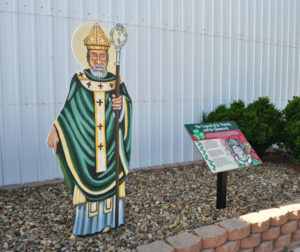
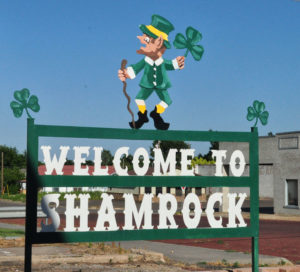
If you didn’t know the Blarney Stone was in the park, you might stop anyway just to snap photos of the cute signs depicting St. Patrick and a leprechaun. But since it is, well…what harm can a kiss do?
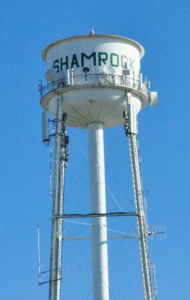
WATER TOWER
Shamrock is also home to a different sort of “tower” – the tallest riveted water tower in the state….and you know how we Texans like to build the biggest and best. I must admit I’ve never seen such attention and documentation given to a tow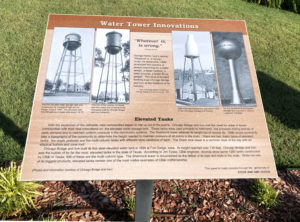 n water tower. It’s definitely worth a few minutes to wander the lot where it stands downtown and take in some of the old photos, informational plaques and murals that explain how they constructed this monster. Taking into consideration that it was built in 1915 and cost just over $6,000, it’s pretty impressive.
n water tower. It’s definitely worth a few minutes to wander the lot where it stands downtown and take in some of the old photos, informational plaques and murals that explain how they constructed this monster. Taking into consideration that it was built in 1915 and cost just over $6,000, it’s pretty impressive.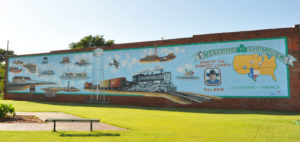 .
.
Shamrock also still has a handful of motels that have survived several reincarnations since the days of Route 66, and a beautifully restored 1926 Magnolia gas station.
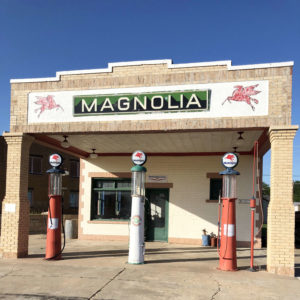
You’ll thank your lucky stars – or clover – if you take the time for a stop in Shamrock.
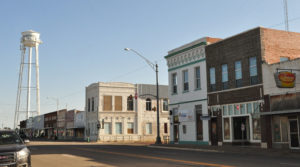
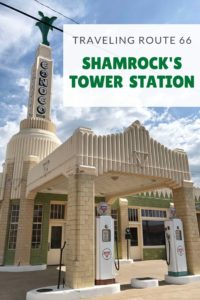

 It was a grand undertaking that took two years to complete, but has provided a jewel of a centerpiece to the town square for generations.
It was a grand undertaking that took two years to complete, but has provided a jewel of a centerpiece to the town square for generations.



























 .
.


